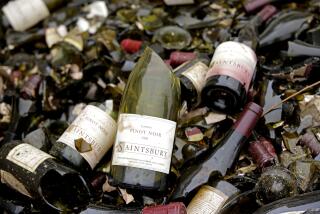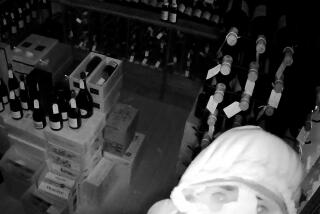Half Liter News: Another Wine Bottle Size Legalized
- Share via
The approval by the federal government of the 500-milliliter bottle size for wine opens up options for wine makers as well as for consumers, according to the man who got the bottle size approved.
George Vierra, president of Merlion Winery in Napa, said the new size has broad implications for consumers.
“I’m very excited about this because it gives consumers another size when they dine,” said Vierra. “Especially these days, when we are concerned about moderate consumption, this size will allow a couple at a restaurant to consume the whole bottle of wine with their dinner and not fear reaching a legal intoxication limit.
“Also, I have been concerned over the price of a 750 (the standard 750-milliliter bottle). There are plans to increase the taxes on wine, and when you add new taxes to a bottle of wine, the 750 will go up in price and a lot of it will not be affordable. So the 500 is a way for people to appreciate wine at a lower net cost.”
The proposal will also permit some producers who now have a limited quantity of wine on allocation to increase the number of bottles they produce without increasing the amount of wine they make.
“I’m really interested in looking at it,” said Gary Farrell, who makes only a tiny amount of his Howard Allen Pinot Noir each year. “I could make 500 cases of it instead of 300 and spread it out to a greater number of people. Also, I think it’s a great idea because a 750 is usually too much for two people at dinner. They usually leave some behind.”
Farrell added: “I wonder how much resistence there will be from the first shipments of 500s. And restaurateurs will have to put some sort of explanation on their wine lists, so there’s no confusion about what they’re selling.”
Large producers had reservations about the 500 initially. John Fetzer, president of Fetzer Vineyards in Mendocino County, said he had mentioned the 500 to Fetzer’s sales staff and the initial reaction was negative because it added a new sales problem.
“We really are not eager to do it, but in restaurants it may be applicable,” said Fetzer. He said wholesale distributors “are in a mode not to add to warehouse items. And with any winery our size, it has a tremendous impact on inventory costs.”
Fetzer produces about 2 million cases of wine a year, about 80,000 cases bottled in 375-milliliter bottles, the so-called half-bottles. Fetzer said he may replace some of the half bottles with 500s as a test. “We have to explore it with a specific wine, perhaps with our Sundial Chardonnay, to see what the public and the trade’s reaction is to it.”
Peter Haywood of Haywood Winery, who sought BATF permission to market a 500-ml bottle in 1986 and was turned down, said he was still interested in the idea.
“I have always thought they made sense, and since we’re always allocated on our Zinfandel and Fume Blanc, they would spread further in half-liter bottles. So I will consider it.”
But Haywood pointed out a problem: “A lot of restaurateurs don’t want to mess with it because of the additional storage space a new size requires. So some people will be cautious. It’s a matter of how well the market receives it.
“I think the consumer will be eager to try them and they will appreciate the more convenient size, and eventually I think the retailer and restaurateur will have to carry them.”
The change in the BATF’s Standards of Fill regulations was the first since 1981, when the 50-milliliter bottle was approved. (BATF eliminated the 500-ml bottle as a legal size for distilled spirits about two years ago.)
The 500 holds one-third less wine than the 750 so will make less wine available at a lower price. A $15 wine typically sold in a 750-ml bottle could be marketed for $10 in the smaller size.
“Ultimately, 25% of our production at Merlion will be in 500s,” said Vierra.
A spokesman for the Bureau of Alcohol, Tobacco and Firearms said formal approval of the 500-ml bottle, which holds about 17 ounces, will be published in the Federal Register next Tuesday. Bottles may be shipped beginning Feb. 20, 1991.
The approval followed a three-year effort by Vierra to gain approval for the bottle. His formal petition to BATF, submitted last March, was signed by dozens of wineries. During a public comment period, BATF received only three negative responses.
Vierra said one drawback to the 500-ml bottle was the cost of the bottles. The only widely available 500-ml bottles are from France and thus expensive. He said, however, that Owens-Illinois, a large manufacturer of wine bottles, said it had a mold for the 500 and that it expected to have bottles ready for sale within three or four months at a competitive price.
One of Owens-Illinois’ initial ideas was to package 500s in 15-bottle boxes, so each case would hold 7.5 liters of wine. Standard 12-bottle cases of 750s hold nine liters of wine.
One winery that actively campaigned for the 500-ml bottle and said it would use it was Jordan Winery in Sonoma County. Also, Dehlinger Winery in Sonoma test-marketed 500s in 1986 in California with great success. But until late last week, the size was illegal for interstate transit.
A spokesman for the BATF said, “Our concern has always been that the 500-ml sat in that bracket between the 375 and the 750, the table wine standard, and that the 500 was so slightly different in size that that might confuse some consumers.”
But the spokesman said Vierra’s petition “was widely supported by the industry.”
Wine of The Week
Toselli ($6)-- This is the first nonalcoholic wine that actually tastes like what it’s supposed to emulate. It’s an Italian import made from the Muscat grape to resemble an Asti Spumante. Most Asti Spumante (already a low-alcohol beverage) is better than this product, but Toselli is fresh, smells like a Spumante and has just enough sweetness to give it texture in the mouth. Yet it’s not so sweet that it’s cloying. It’s carbonated (the bubbles are injected, not a result of an additional fermentation), so it doesn’t come across like Spumante on the tongue, but it’s an attractive dessert “wine” with none of the drawbacks of sparkling wine.
More to Read
Inside the business of entertainment
The Wide Shot brings you news, analysis and insights on everything from streaming wars to production — and what it all means for the future.
You may occasionally receive promotional content from the Los Angeles Times.










